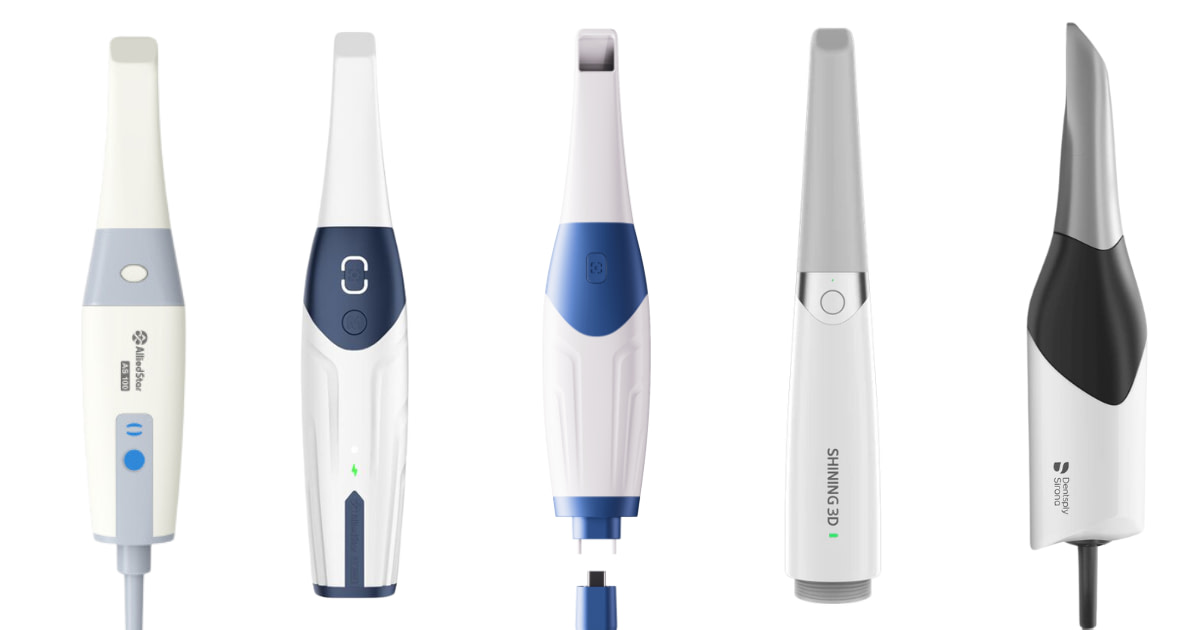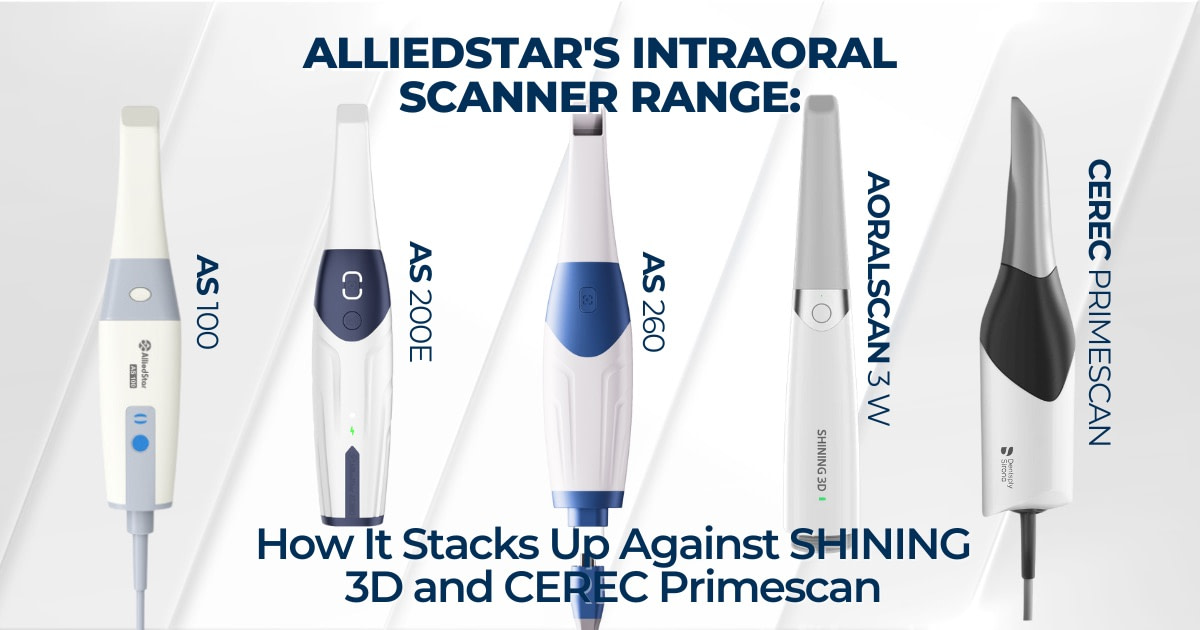As the intraoral scanner (IOS) market becomes increasingly saturated with options, it's crucial for dental professionals to understand how different devices compare in real-world applications.
In this edition of iDD Compares, we're putting five intraoral scanners under the microscope: the Alliedstar AS 100, AS 200E, and AS 260, the SHINING 3D Aoralscan 3 Wireless, and the Dentsply Sirona CEREC Primescan.
Our goal is to provide you with in-depth, unbiased comparisons that go beyond mere specifications and offer practical insights to inform your decision-making process.
Whether you're considering your first IOS purchase or looking to upgrade your existing equipment, this comparison aims to help you navigate the complex landscape of intraoral scanning technology.

From left to right: Alliedstar's AS 100, AS 200E & AS 260, SHINING 3D Aoralscan 3 Wireless and Dentsply Sirona CEREC Primescan
Intraoral Scanners at a Glance
Before diving into the details, let's take a quick look at how these scanners compare in terms of key specifications and pricing:
Alliedstar AS 100
The AS 100 is Alliedstar's entry-level scanner that is now discontinued. It was designed to introduce practices to digital dentistry without breaking the bank. It features a compact, lightweight design that's easy to maneuver in the patient's mouth. For those that have this scanner - it is interesting to compare it to the later generations of Alliedstar
- Price (USD): around $5,000
- Weight: 198g
- File Formats: STL and PLY
- Software Platform: AS Connect
Alliedstar AS260
The AS 200E represents Alliedstar's mid-range offering. This is basically the same as the AS100 but with an improved scanner body and ergonomics. It is lighter and looks a lot better. While the AS 100 looks very industrial, the AS 200E is more modern. This scanner replaced the AS100, which is one again, discontinued.
- Price (USD): $8,995
- Weight: 175g
- File Formats: STL and PLY
- Software Platform: AS Connect
Alliedstar AS200E
Previously Alliedstar's flagship before the SENSA, the AS 260 is again built on the same core Alliedstar scanning technology, but it is wireless. In fact, it is one of the most affordable wireless scanners on the market today.
- Price (USD): $11,995
- Weight: 245g (including battery)
- File Formats: STL and PLY
- Software Platform: AS Connect
SHINING 3D Aoralscan 3 Wireless
The Aoralscan 3 Wireless from SHINING 3D is the company's second wireless scanner offering built on the successful Aoralscan 3. Aoralscan has arguably the best scanner software out of all Chinese IOS.
- Price (USD): $14,000
- Weight: 350g (including the battery)
- File Formats: STL, PLY, and OBJ
- Software Platform: SHINING 3D DentalCloud
Dentsply Sirona CEREC Primescan
The CEREC Primescan from Dentsply Sirona is widely regarded as one of the most accurate intraoral scanners on the market. It is well-regarded by clinicians globally and represents a good scanner against which to test.
- Price (USD): $23,000
- Weight: 457g (with disposable scanner sleeve) or 524g (with metal scanner sleeve)
- File Formats: STL and PLY
- Software Platform: CEREC
Scanning Methodology
To ensure a fair and comprehensive comparison, we go through the same scanning process.
Case Selection: We scanned the same patient case (a 36-crown prep) with each IOS immediately, one scanner after the other, allowing for direct comparison across all scanners.
Operator Consistency: I performed all scans.
Multi-faceted Analysis: We analyzed the results in both native software and third-party applications, focusing on:
- Scan quality (color and monochrome)
- File characteristics (formats, sizes, mesh density)
- Clinical usability (margin clarity, overall accuracy)
Deviation Analysis:
We used the CEREC Primescan as a reference point for deviation analysis, given its dubbing as the gold standard for accuracy in intraoral scanning. Below are the results of the individual scans—pictures of the color scan, exported STLs, tessellated mesh, and a close-up of the prep margin.
In regards to scanning. All these scanners made this crown prep easy to work on. The CEREC Primescan, with its large FOV, did it the fastest, followed by the Alliedstar scanners. The Alliedstar scanners all felt the same. They all seem to have the same scanning tech as even the scan texture is almost identical across all scanners.
One thing I noticed is how good the tissue filtering is for the AS scanners. It is excellent to ignore cheeks etc. Primescan still does not have the best tissue filtering algorithms. The Shining 3D Aoralscan 3 is also very fast. It works well. It has a smaller scanner head with a narrow beak-like tip which makes it easier to scan at the back of the mouth, but the trade-off is a smaller FOV and thus takes more passes to get all details. Overall all scanners worked well.
Scanning Results
Native Software Scans
Every intraoral scanner is equipped with scanning software. The scanner's native software allows us to preview how these scanners capture color (called texture).
Color Scans
Every scanner captures color slightly differently, depending on how accurately it can pick up the light bouncing back off the prep and adjacent teeth. The software's algorithms also depend on how accurately they can convert this data into color.

Now, the most striking observation we can make, just at first glance, is Primescan's scanning color (texture), which presents a more cartoon-style aesthetic. The Aoralscan 3 Wireless is the brightest and most photo-realistic scan of the bunch. All Alliedstar scans produced similar color scans, which appear less bright and cooler in color tone than the Primescan.
Monochrome Scans
Monochromatic scans can also be taken and previewed in their native software. By looking at scans in monochrome, one can get a better view of the prep's quality, and is even recommended to check for any scan issues that are not as obvious when viewed in color.

As expected, CEREC Primescan demonstrated the most detailed occlusal morphology and clear margin lines. This level of detail is particularly valuable for restorative work.
Again, AS 100, 200E, and 260 from Alliedstar showed a similar level of detail in monochrome, and all provided clinically acceptable results.
Surprisingly, the least detailed monochrome scan was Aoralscan 3 Wireless.
Exported Scans
All intraoral scanners are open, which allows scans to be exported and sent to labs.
By exporting the scans outside their native software, we can view the scans objectively without the customized color and optimized surface rendering of the individual scanner’s built-in software.
You can use any third-party CAD software to examine the amount and detail of data captured in each scan; in this case, we used Medit Design.

File Formats and Sizes
These scans are usually exported in three formats: STL, PLY, or OBJ files.
STL files are exported as monochromatic scans, whereas OBJ and PLY files store color (texture).
Not all intraoral scanners can export OBJ and PLY files, whereas STL files are widely used as the industry's default setting.
This particular set of scanners is capable of exporting scans in these formats:
- SHINING 3D Aoralscan 3 Wireless—This is the most versatile iOS, as it offers STL, PLY, and OBJ file formats.
- Alliedstar AS 200E and AS 260 - Offers options for color and monochrome scans with STL and PLY file formats.
- CEREC Primescan - STL (and PLY can be exported if connected to a lab via DS connect).
- Alliedstar AS 100 - STL only.
Intraoral Scanner | STL | PLY | OBJ |
|---|---|---|---|
Alliedstar AS100 | 4.8 MB | - | - |
Alliedstar AS200E | 5.2 MB | 2.2 MB | - |
Alliedstar AS260 | 4.8 MB | 2 MB | - |
SHINING 3D Aoralscan 3 Wireless | 10.4 MB | 10.5 MB | 14.2 MB |
Dentsply Sirona CEREC Primescan | 17.7 MB | - | - |
Mesh Density Analysis
Based on the table above, we can see that the file sizes of each IOS differ significantly.
The higher resolution or encoding of larger-sized objects requires more facets (triangles within the tessellation) to cover the 2D surface of the scan.
Labs often use third-party CAD software like exocad. In this case, we used Medit Design to preview the received STL, PLY, or OBJ files and to take a closer look at the amount and detail of data captured within each scan.

So we can summarise the mesh density in relation to the file size as follows:
- Primescan (densest)
- Aoralscan 3 Wireless
- Alliedstar scanners (least dense)
All Alliedstar scanners have very similar file sizes, again supporting the idea that the hardware across all these scanners is fundamentally the same.
It's important to note that while higher mesh density can provide more detail, it doesn't always correlate directly with accuracy or clinical outcomes.
Margin Analysis
This software can also review prep margins. Clear margin capture is crucial for the fit of final restorations.


Here's how the scanners performed:
As expected, Primescan seemed to have the most detail, with a prominent margin line visible across all areas. CEREC Primescan is commonly dubbed the gold standard of intraoral scanners and one of the most accurate on the market. The file sizes from Primescan are also the largest, and the mesh density is the densest, which may be why the scans look so detailed.
Aoralscan 3 Wireless seems to follow closely with the detail of the margin line when viewed both buccally and lingually.
When we look at the Alliedstar IOS line, the quality of the scan and margin capture seem to correlate with the scanner price. By this, I mean that the more premium and higher-end IOS, the AS 260 captured better detail than that of the medium-range AS 200E and budget-friendly AS 100. Now that’s not to say that these details from each of the Alliedstar devices aren’t accurate, but they are not as crisp as the detail captured by Primescan or SHINING 3D.
It’s important to remember that all IOS work well and are fast to use in cases like this simple crown scan, and all are accurate. What it comes down to is your preferences, budget, and what extra features you prefer to have in a device, such as AI capabilities.
Deviation Analysis
When looking for deviations, we used Primescan as our reference point to compare all the other scanners. All scanners showed deviations within 50 microns, which is well within the range of clinical acceptability. The sectional view of the crown prep revealed minimal differences between the scans, which suggests high consistency across all devices.

Conclusion
After extensive testing and analysis, it's evident that all five scanners, the Alliedstar AS100, AS200E, AS260, SHINING 3D Aoralscan 3 Wireless, and Dentsply Sirona CEREC Primescan, are all capable of producing clinically acceptable results.
Nowadays, it’s a given that all intraoral scanners on the market are accurate.
The optimal choice among these will largely depend on your practice's specific requirements, financial considerations, and preferred digital workflows. We strongly recommend hands-on trials of these devices, which can often be arranged through your local representatives.
Let us know what intraoral scanners you’d like us to include in our next iDD Compares!
As always, leave any comments and questions you have below, and we’ll get back to you soon.


Sensa VS aoralscan 3 w
Sensa = better endentulous scanning i find because of the larger head compared to aoralscan 3.
Aoralscan 3 = more software development and features
Between the AS200e and the AS260 are there any differences aside from price and the wireless connectivity of the AS200e? Which do you recommend?
In terms of function – no. They are basically the same. If you prefer wireless go for the 200E. If not, 260.